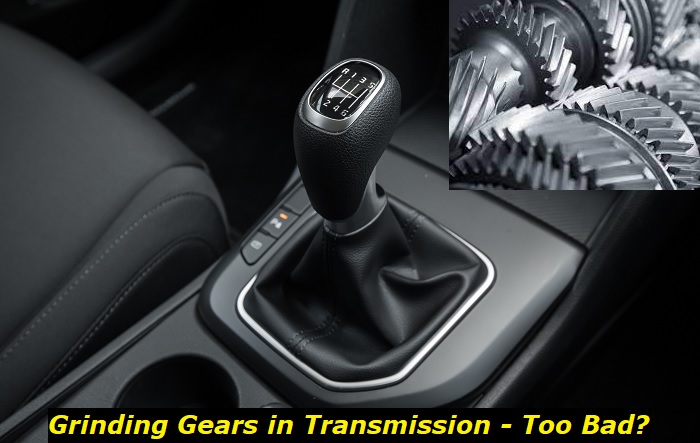Grinding gears once or twice is not a big deal - everyone dies it once in a while. But if you do that too often, you should adjust your driving style. This may lead to gear wear and tear and eventually, your transmission may stop working. It will only lead to bad wear of the gears, but the clutch has nothing to do with this.
Manual transmission use tips highlights
- Level of importance:High
- Problem prevention:Maintenance, careful driving
- Needed expertise:No
- Needed tools:No tools
- Time taken:1-2 hours for practicing or learning
- Possible issues:Transmission failure, overloading, overheating, destroying gears, burning clutch.

Grinding gears - what does actually happen?
In a manual transmission, you manually match the different gears with the main gear. This may be happening in different patterns but the result is always the same - the main gear is matched with a certain gear in the transmission and you may drive. The size of gears changes the way the engine torque and power are transferred to the wheels of your car.
But the moment when two gears go together is not that safe. If there wasn't a clutch, you would destroy the gears when trying to match them. But the clutch actually disconnects the transmission from the engine and the main gear doesn't rotate for a while which lets you install the gear to the needed position.
Here's how it should be done:
- You drive in a certain gear, let's say in the second one, and it's time to shift.
- You press the clutch and the clutch system disconnects the main gear from the engine, so it stops rotating.
- Now, when the transmission is not powered by the engine at all, you shift the gear while keeping the clutch pedal pressed.
- Once you shift the stick shift to the third gear, you slowly release the clutch until it connects the transmission with the engine again.
- After the clutch is fully released, the engine drives the transmission again, but the system is not in the third gear.
So, basically, when you operate the stick shift, the transmission must be disconnected from the engine by the clutch system. And this is why the main gear shouldn't be rotating. Otherwise, you couldn't use the needed gears because it's impossible to connect two gears that are rotating.
When your gears grind, it means that the main gear is still rotating when you are trying to connect it with the gear of a certain speed in the transmission. It means that something is wrong in the way you operate the clutch and stick shift or maybe something is wrong with the transmission itself.
Why does the grinding of gears in manual transmissions occur?
Your manual transmission may grind gears for several reasons. It may be because of you or because of the worn-out elements in the transmission. I decided to list the most common reasons why gears may grind in your manual transmission.
Let's have a look at them:
1. You don't press clutch deep enough
The clutch pedal needs to be pressed to the metal when you shift gears. Even if the clutch only catches the gear when the pedal is almost fully released, it should be completely pressed when you operate the stick shift. Otherwise, grinding will most likely occur.
2. You release the clutch earlier than needed
This very often happens when you are in a hurry. In this case, you will release the clutch before you actually engaged the needed gear and the final phase of engaging happened when the clutch started connecting the transmission with your engine. This is why the gear started gridning before it was engaged.
This is one of the most dangerous ways to operate the clutch because the rotating main gear will easily destroy the gear of a certain speed in your transmission. You should avoid such occasions. But again, doing this once or twice a year will not cause any serious consequences.
3. The clutch is dead
When the clutch is not working properly, you will experience gear grinding very often. Such condition of the clutch means that it will not disconnect the transmission from the engine completely and the main gear may be rotating when you are trying to engage at a certain speed.
4. The clutch pedal needs adjustment
In the majority of cars, the clutch pedal is connected to the clutch in the transmission by a metal wire. If this wire is stretched, it's natural that you will not be able to disengage the clutch plates. It means that the clutch will always be engaged even a little and the main gear in your transmission will always be rotating.
This is something that causes gear grinding in any situation, even when you press the pedal to the metal. Sometimes, the clutch wire may be adjusted, but in many cases, it will have to be replaced.
How to prevent gear grinding in your vehicle?
Of course, driving a manual car is much more complicated than driving a vehicle with an automatic transmission. If you experience constant problems and unpleasant grinding with the transmission, maybe, it's a good idea to look for another car that is equipped with an automatic transmission.
If you still want to drive a manual car, you should remember such important tips to avoid gear grinding:
1) Get more experience
You should drive your car more and get used to the way the gears are engaged in the transmission. Grinding gears now and then it's absolutely OK, especially when you only start driving a manual car.
2) Check the clutch
If this unpleasant thing happens quite often, you will most likely need to check the clutch and clutch wire. Maybe, there is a problem with the equipment and this causes gear grinding problems.
3) Take your time to get used to the clutch
Just drive slowly and carefully to understand when it is OK to release the clutch pedal and how deep you should press it, in the first place. Drive slowly and feel the car.
4) Check the transmission
Sometimes, in older cars with high mileage on them, you may get gear grinding problems just because the gears or shafts are worn out and need repair or even replacement. In this case, you will have to repair the transmission or buy a new one.
When can gear grinding in a manual car be a problem?
Although I insist that you shouldn't care much about the gear grinding problems, they may be quite annoying and may become a problem if they happen too often. It's important to understand the actual reasons why this happens and if there is a problem with the clutch or the transmission, you shouldn't just keep driving and ignore this issue.
Here are the signs that gear griding requires a lot of attention urgently:
- your gears grind every time you operate the stick shift in your car;
- the grinding is pretty hard and you can even feel the car vibrating when this happens;
- the gears grind even when you do everything right in terms of clutch pedal operation;
- the griding occurs in a certain gear and you can't prevent this from happening.
If you have these issues in your car, it's important to find the reason and repair the clutch or the transmission as soon as possible. Even though manual transmissions are way cheaper to maintain, repair, or replace than automatic ones, you will obviously need a lot of money if you ignore the problem and the transmission just falls apart.
Ignoring the issue is only possible if gear grinding is the result of your wrong actions behind the steering wheel. In this case, you may just get some more experience and learn how to operate the stick shift.
Final thoughts
Even though gear grinding is not a big deal and isn't that common in the world where 90% of cars are automatic, it's worth understanding this problem and knowing where it comes from. In this article, I listed the reasons for gear grinding and also showed the ways to cope with the problem.
It's important to not ignore problems with your transmission. Whether it's an automatic transmission or a manual one, it should be repaired if it shows the symptoms of failure. Otherwise, the fatal problem with the transmission will cost you thousands of dollars to solve.
If you have experience with gear grinding in manual cars, share it in the comments below!
About the authors
The CarAraC research team is composed of seasoned auto mechanics and automotive industry professionals, including individuals with advanced degrees and certifications in their field. Our team members boast prestigious credentials, reflecting their extensive knowledge and skills. These qualifications include: IMI: Institute of the Motor Industry, ASE-Certified Master Automobile Technicians; Coventry University, Graduate of MA in Automotive Journalism; Politecnico di Torino, Italy, MS Automotive Engineering; Ss. Cyril and Methodius University in Skopje, Mechanical University in Skopje; TOC Automotive College; DHA Suffa University, Department of Mechanical Engineering






Add comment